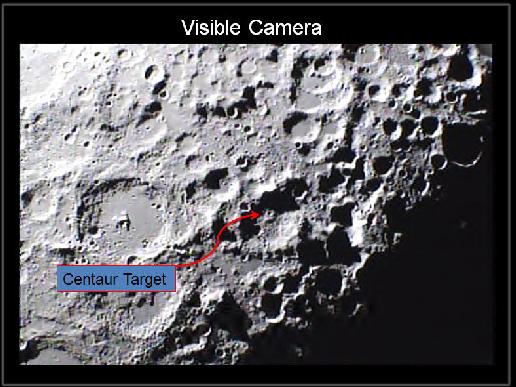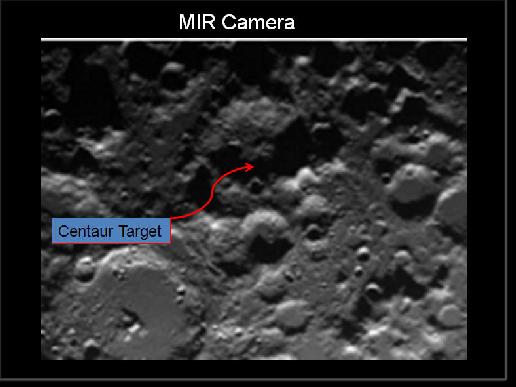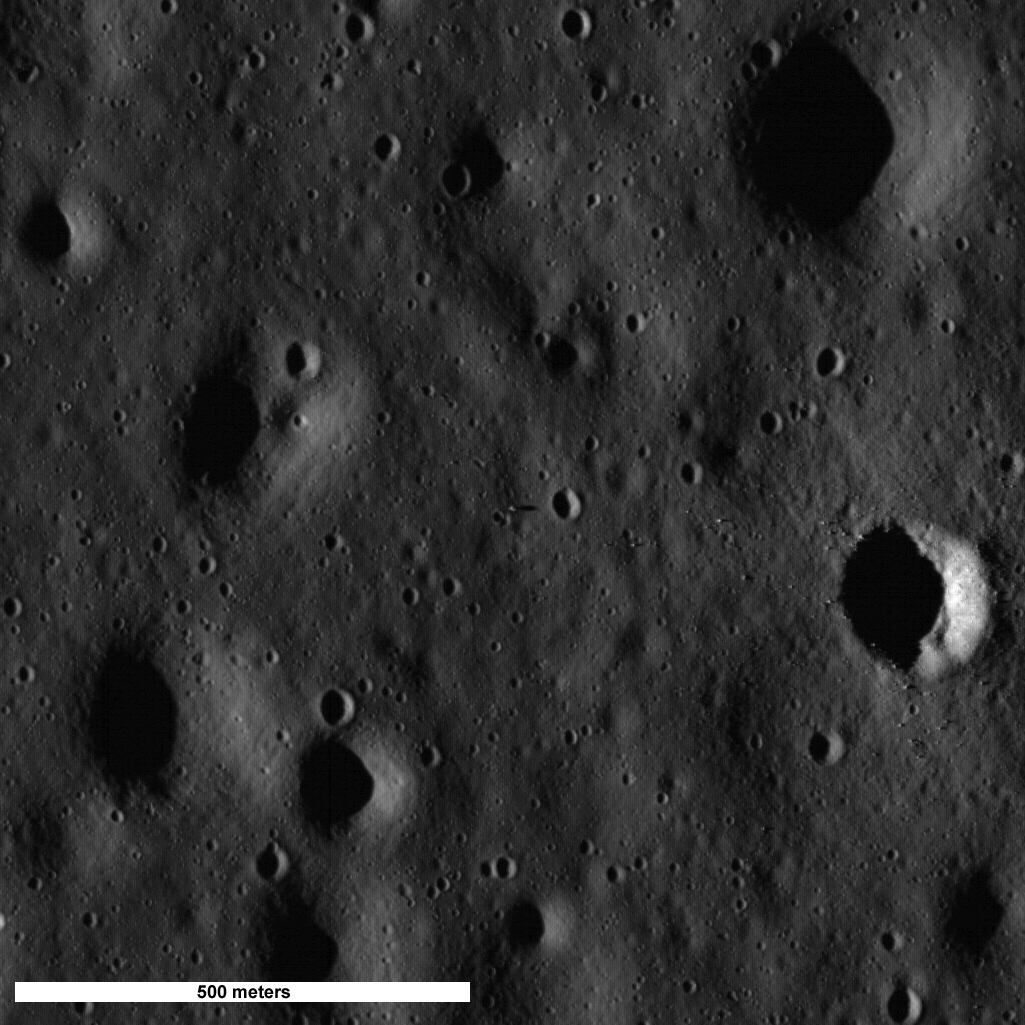“It took pilots 50 years to progress from scarf-and-goggles barnstorming to setting down footprints on the Sea of Tranquility; it will have taken another half-century for us to return to the moon.” – David Nolan writing in Popular Mechanics, March 2007 (according to the latest from NASA, we won’t be returning even after another half-century has passed)
It was to be such a big event that NASA decided to throw an all-night party at its Ames Research Center to celebrate. There were guest speakers, Moon-themed movies, and a big screen set up for the main event – what NASA billed as the “Spectacular LCROSS Lunar Impacts.”
According to a media advisory, “NASA’s Lunar CRater Observation and Sensing Satellite (LCROSS) mission will come to a dramatic conclusion at approximately 4:30 a.m. PDT (7:30 a.m. EDT) on Friday, October 9, 2009, with the impact of the LCROSS Centaur upper stage rocket and four minutes later, the impact of the LCROSS Shepherding Spacecraft into Cabeus crater near the moon’s south pole. To mark the event, NASA Ames ResearchCenter is hosting ‘LCROSS Impact Night.’ News media are invited to cover the three-part event that is open to the public and free of charge.”
The news media, the scientific community and amateur astronomers were all suitably excited. Clear back in June, when the mission was launched, Scientific American explained to readers how “Scientists expect the blast to be so powerful that a huge plume of debris will be ejected.” The second impact, the magazine further explained, would produce “a spectacular explosion that should be visible in amateur astronomer’s telescopes.”
The plan was that the first impact would send up a huge cloud of lunar dust and debris, and the larger spacecraft would then follow the same course, directly through the cloud, before necessarily crashing into the surface of the Moon. It would only have four minutes to gather data and transmit it back to Earth. As the LA Times explained the day before the big event, “if all goes according to plan, the spacecraft will fly through the cloud of debris that will rise above the lunar surface and linger there briefly. As it passes through the cloud, the satellite’s nine instruments will analyze the dust and debris for evidence of water, before crashing itself.”
So in addition to providing a spectacular show, the mission was also going to feed the American public’s need for instant gratification by providing relatively quick results. In that short four-minute span of time, we would gather all the data needed to determine within days if there is water frozen in deep craters on the Moon. The Times noted that, “Scientists preparing for the collision could hardly contain their excitement over what might turn up in that short time.” The crowd at Ames was expected to number in the thousands, possibly even as many as 10,000, all there to see “a dust cloud rising as much as six miles above the lunar surface, providing a rare show for amateur astronomers with telescopes 10 inches or longer.”
I would have guessed that very few, if any, amateur astronomers have telescopes 10 inches or longer, but I could be wrong. Or maybe I’m thinking of something else.
In addition to the gathering at the Ames complex, countless other viewing parties were organized around the country and around the world to view NASA’s live footage. Amateurs were dutifully lined up at their telescopes awaiting the show. And, as the Times noted, “observatories around the world will be watching, along with the Hubble Space Telescope and the Lunar Reconnaissance Orbiter.” Steve Hixson, vice-president of Advanced Concepts at Northrop Grumman, the manufacturer of the spacecraft, assured reporters that the craft was “looking great. I don’t think we could miss the Moon now if we tried.”
I would hope not. How hard, after all, could it possibly be? A full forty years ago we were able to set a manned spacecraft gently down on the Moon – and then fire the engine back up and fly home! Now, with four decades of additional experience and vastly improved technology, all we had to do was send an unmanned spacecraft on a one-way mission to crash into the Moon. How could NASA possibly screw that up?
The media kept referring to the LCROSS mission as the “bombing” of the Moon. Given that NASA is essentially an arm of the US Department of Defense, this should have been a cakewalk. The last time I checked, no one knew more about dropping bombs and firing missiles than the U.S. military. No other country on Earth has come anywhere close to dropping as many bombs on as many parts of the world as Uncle Sam has. The Moon may well be the only landmass within reach of the United States that we haven’t bombed before.
With the United States having long led the world in both lunar exploration and blowing shit up, this mission couldn’t have really been any easier, so it came as no surprise that everyone seemed to be brimming with confidence. President BlackBush, Nobel Peace Prize in hand, was reportedly heard to say: “How do you like me now, motherfuckers?! I’m going to bomb the motherfucking Moon! You all thought that punk-ass bitch that preceded me was arrogant? Watch how I roll!”
As it turned out, the front-page space that all the major media outlets had undoubtedly set aside for the dazzling images wasn’t needed after all. With all eyes on the Moon, what all those viewing parties and all those amateur astronomers and all those giant telescopes saw was … absolutely nothing. The first impact, which was supposed to be captured on live video beamed back from the second spacecraft, never materialized. As the LA Times politely put it, “the plume failed to show on screen.” There is an explanation, of course: “Some scientists suspect the camera settings on the second spacecraft were incorrect, preventing it from spotting the plume.”
Yes, that must be it. You would think though that, what with the importance of the second craft being able to see the plume so that it could then fly through it, they would have gotten that detail right. But apparently they just don’t have the quality control over at NASA that they had back in 1969. As for why none of the amateur or professional telescopes aimed at the Moon captured the first plume, or the allegedly even larger second plume, NASA is going to have to get back to you on that. But probably not right away.
The Times was quick to reassure readers that “scientists might still pluck success from the mission’s anticlimactic ending … At a news conference more than two hours after the crash, mission scientists confirmed that the Centaur rocket made a crater when it hit, and that crater was about the expected size of more than 60 feet across.” There is no way to confirm that claim, of course, since the ship allegedly impacted inside a two-mile deep, pitch-black crater that hasn’t seen daylight for millions of years – which is exactly why it was targeted.
And how pointless, by the way, was this mission? The goal was supposedly to discover if there are large deposits of frozen water on the Moon that could be mined to provide water, breathable oxygen and rocket fuel for future lunar exploration and colonization. The water, if it exists, is at the bottom of deep, permanently dark craters where the temperature is said to hover at around -400° F. At those temperatures, the scientific community tells us, the water would be frozen as hard as rock.
Even if we assume that NASA could overcome all the problems with getting astronauts to the Moon and guaranteeing their survival while there, how exactly would they recover that water? Toss bombs in the craters and then try to run around and gather all the chunks of ice before they melt in the +280° F heat of the sun? Drive down into the craters in one of those folding dune buggies with floodlights, a couple of battery-powered jackhammers, some warm clothes and a shitload of batteries? Or are we going to build a giant, mechanized water-extraction facility of some kind with parts brought up one-at-a-time from Earth? How long do you suppose that will take?
It’s anyone’s guess what the real purpose of this mission was, but whatever goals were being pursued, it doesn’t seem to have gone so well. All that can be said for sure is that NASA appears to be but a shadow of its former self. Once upon a time, we were able to blast men off into space and then turn on our televisions and watch them, just four days later, stroll around on the Moon! Nowadays we send off an empty spaceship, wait patiently for nearly four months, and then watch as NASA fails to successfully crash that empty ship into the Moon.
Since the news media fell asleep at the wheel and failed to bring you the spectacular images that had been promised, I dropped by NASA’s website to pick up a few and bring them to you. The following three photos were labeled as “LCROSS Impact Images.” Following that is a link to NASA’s thrilling live video footage. Enjoy the show. It’s quite dazzling.



Did anyone notice, by the way, all the other ‘lunar modules’ that are recognizable in the larger image captured by NASA’s LRO? As will be recalled, they are recognizable by the long shadows they cast. There are, most notably, probably nearly a dozen of them clustered around the crater to the right of the image. I wonder how the boys at NASA figured out which one was the ‘real’ lunar module?


Looks to me the sun is on the right side of this picture, yet the shadow from what suppose to be the LM is falling to the right. It should be on the left of the LM like it is with the craters.
Sun is from the left. Crater rims on right are illuminated.
I think the shadows are correct. Remember the craters are concave, or below the plane, and the LM is convex, or above the plane. I do though think the actual shadow of the purported LM is way too long for it’s apparent height and the positioning of the light source in comparison with the craters. I think it was exaggerated purposely when created so it would be obvious that a man-mad object was casting a shadow on the surface.
What I want to see is a bunch of dune buggy tracks going all over the surface, not just a rock and a shadow.
I was looking at the same thing. Why is the shadow cast to the right ?
Exactly this is what I thought it was. Opposite shadows.
without the assistance of any ground grew
should read
without the assistance of any ground crew
Oh, what a significant error. Be your helpful post, I honestly thought land grew.
Just by the way, “astronomers with telescopes 10 inches or longer” should read “10 inches or greater” since 10 inches is the diameter of the mirror. Otherwise, thanks for these revelations.
Well, shit. Good catch! Thank you! As an editor, I appreciate this attention to detail (and I definitely want to correct that in the print book!).
It’s a joke. Read the whole paragraph.
just found this site and have read up to here, always been a skeptic but kept the fire alive because hoooraaah ‘Merica and shit but after delving into this amazingly well written tale, I can tell you I feel in my gut we didn’t go and this through look at it more than illuminates why.
Are there any photographs of the astronauts unloading the lunar buggy?
Mr. McGowan or Dave if I may, would have been just awesome(no pun intended) to hang out with and just listen to I would imagine and you would not be able to escape being entertained just by him alone. Very knowledgeable, funny, and a gift of easily seeing the the obvious a lot of us obviously easily overlook or just mostly lack that special ‘gift’ of seeing what we easily should but more if not most often do not. What a cool guy . Thank you Mr.McGowan.
If this commenting is still active…i think the last photo is turned…we should look it from the left, also the light come from the left. so, the white “hills” are not raised earth but the lower parts of the crater. not that it matters…but, i think so.